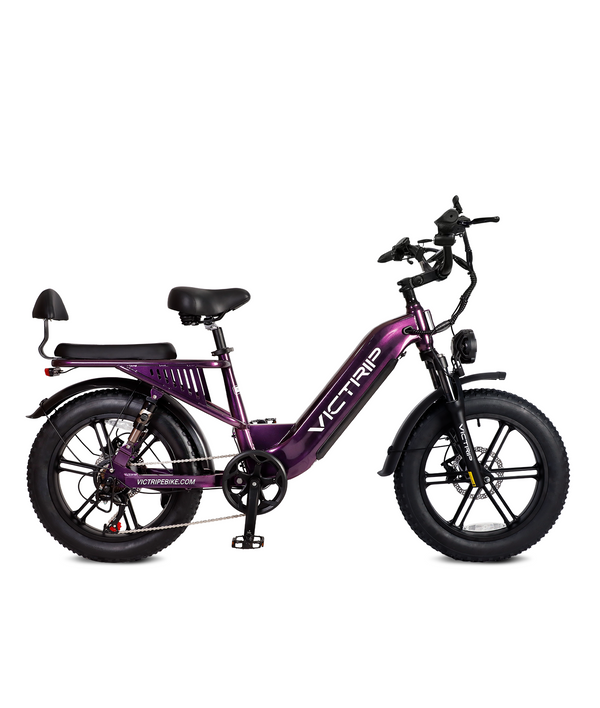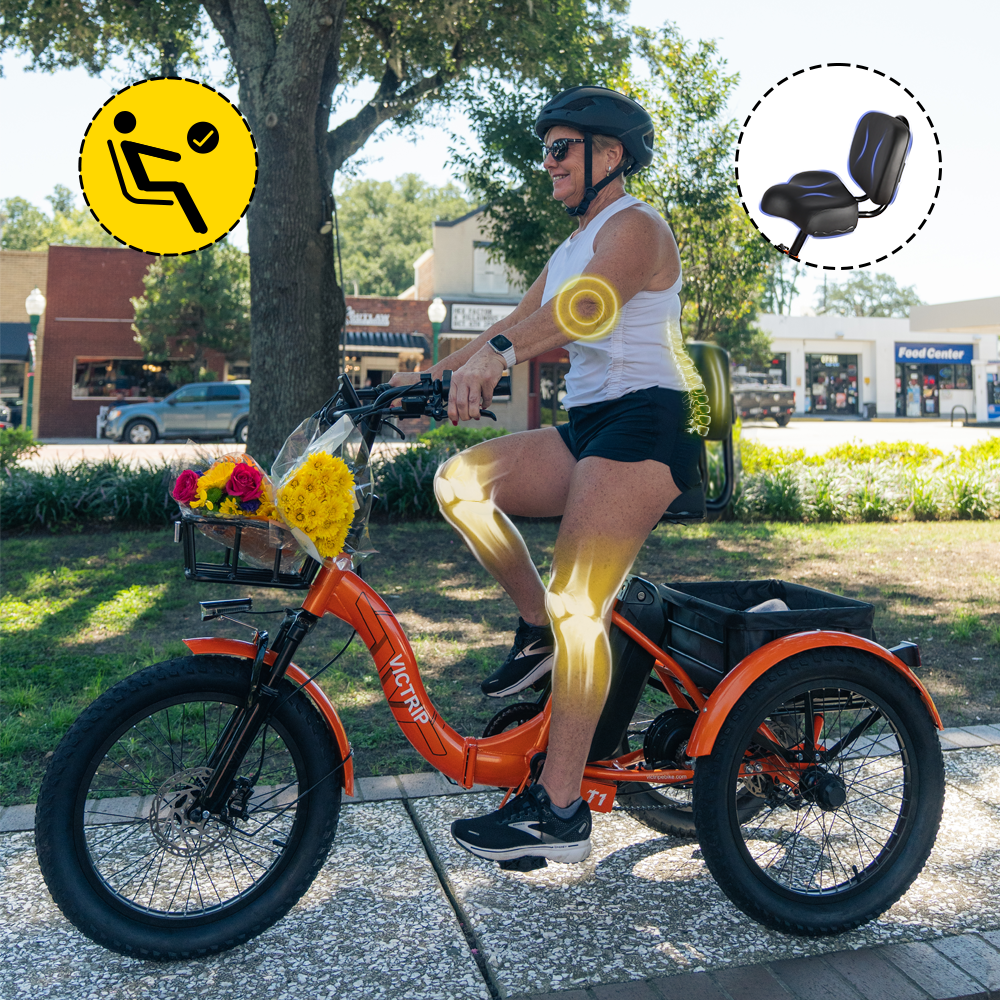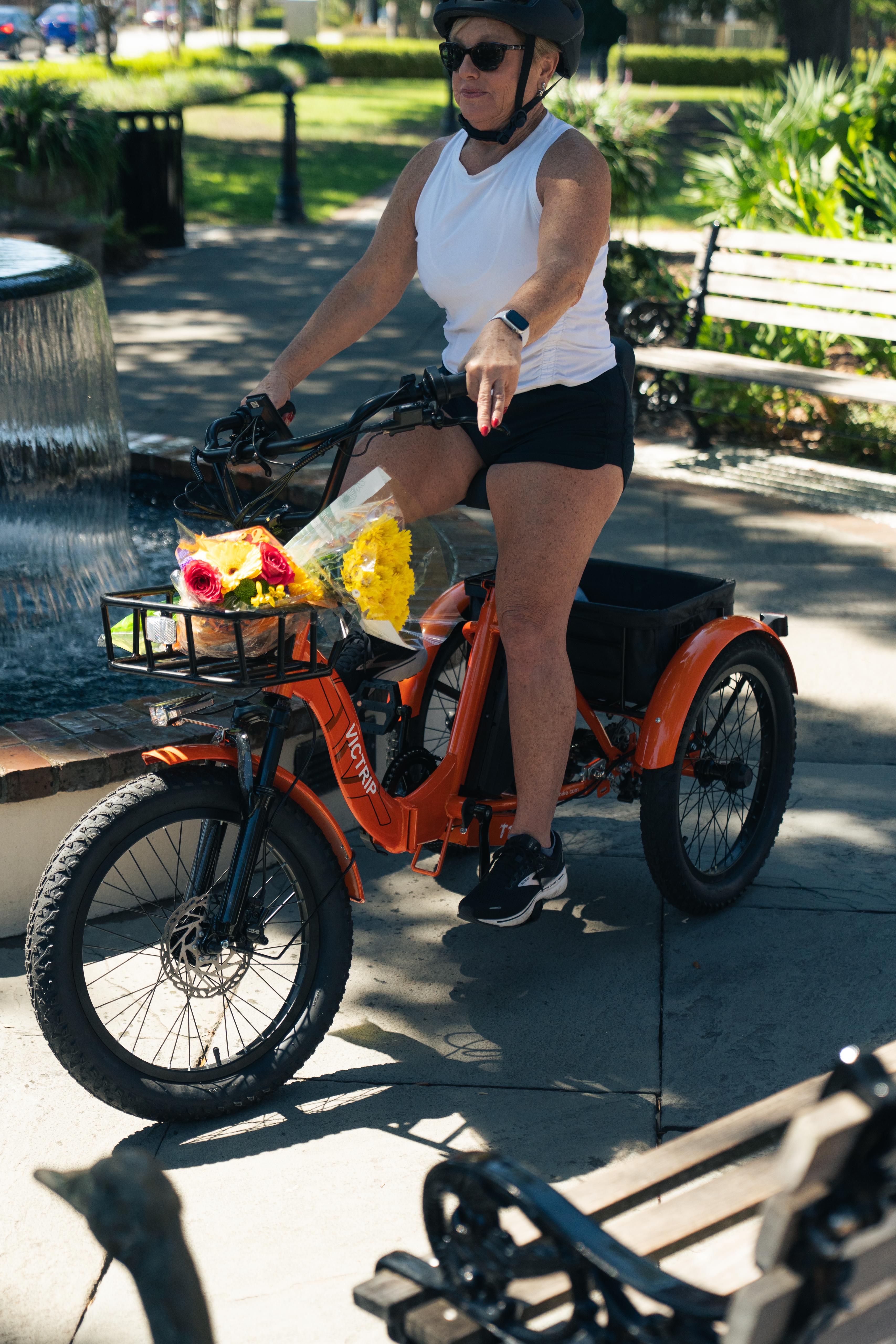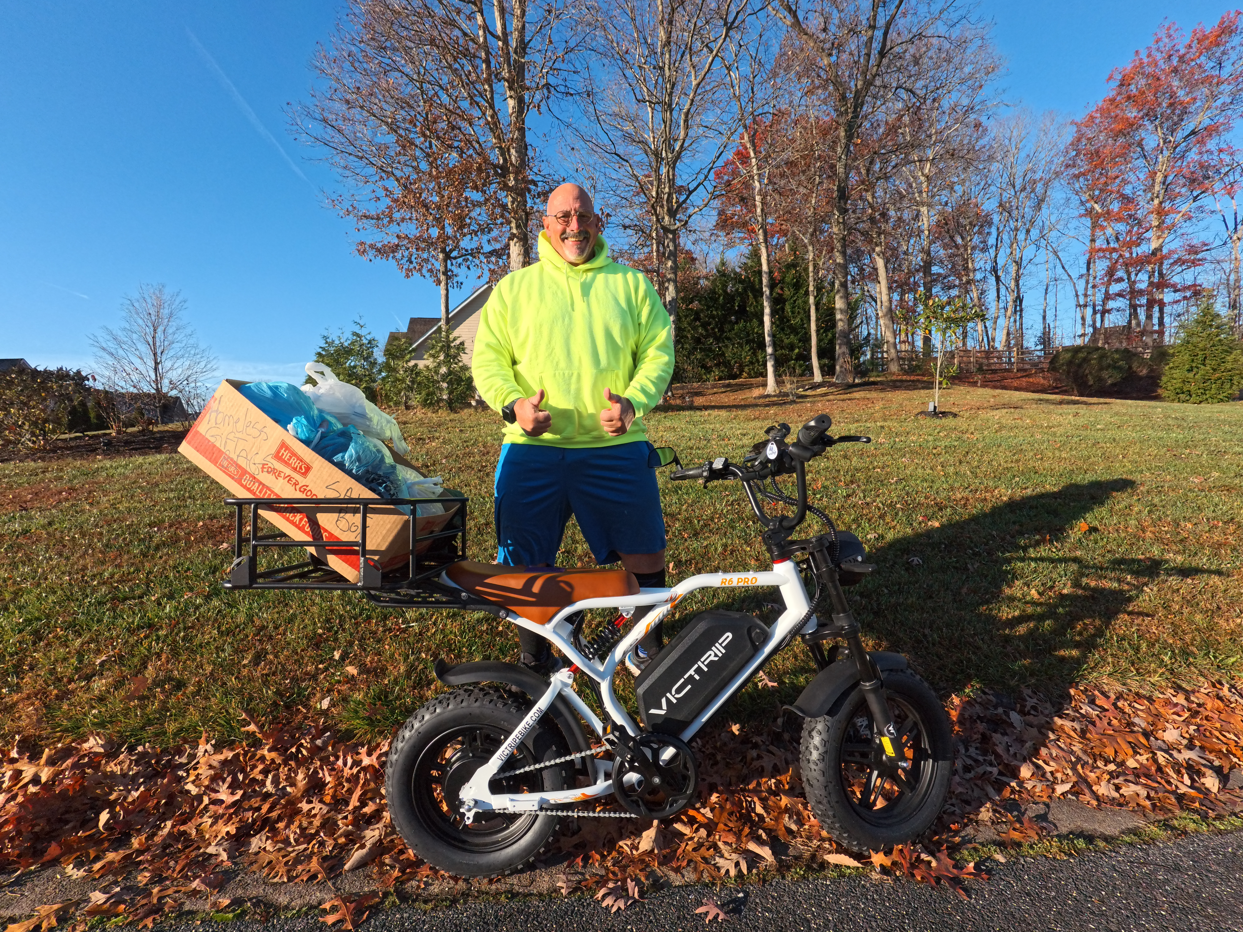Are Step Through E-Bikes Better for Seniors? In short: yes — for many older riders, step-through e-bikes often provide tangible benefits in safety, comfort, and daily usability. They reduce the physical strain of mounting, lower the risk of stumbling, and make it easier to stop and start in urban or suburban settings. That said, the "best" choice depends on individual needs: balance, mobility, local terrain, and rider confidence all matter. Read on for detailed reasoning, buying tips, and practical safety advice.
What is a step-through e-bike? (Definition & basics)
A step-through e-bike is an electric bicycle built with a lowered or absent top tube so riders can easily step through the frame when mounting or dismounting. Unlike the traditional "diamond" or step-over frame — where you lift your leg over a horizontal tube — the step-through lets you swing a leg through a low, open space and sit without excessive hip flexion or lifting. Step-through frames are commonly paired with pedal-assist motors (PAS) and throttle systems, making them ideal for riders who want an extra push on hills or for longer distances.
Why this matters for seniors: reduced hip and knee strain, faster emergency stops, and less awkward maneuvering around clothing or mobility aids. In other words, they’re designed to make the act of getting on and off the bike less of a mini workout — and that small change can yield big safety and comfort gains.

How step through frames differ from step over frames
-
Frame geometry: Step through has low or dropped top tube; step-over has a high horizontal tube.
-
Center of mass & rigidity: Step-over frames are often stiffer (beneficial for sportier riding), but modern step-through designs have closed the gap with reinforced downtubes and integrated batteries.
-
Mount / dismount mechanics: Step-through reduces required hip/knee flexion and lower-body mobility.
-
Aesthetics & ergonomics: Step-through tends to favor upright riding posture; many older riders prefer this for visibility and neck/shoulder comfort.
Seven core benefits of step through e-bikes for seniors
Below, I break down seven key advantages — each paired with practical implications and things to watch for.
Benefit 1 — Ease of mounting and dismounting
One of the most immediate improvements seniors notice is how much easier it is to get on or off. With limited hip flexion, joint pain, or stiffness, maneuvering over a high bar can be risky. A step-through eliminates that obstacle. Practically, that makes short errands, frequent stops, or using the bike for senior transport far less daunting. You’ll be less likely to misstep and more likely to use the bike regularly — and regular use is the real health payoff.
Benefit 2 — Lower fall risk and improved balance
Because you can place a foot down quickly without contorting your leg, balance recovery is faster. If you’re stopped at an intersection, you can stabilize yourself and avoid toppling over. This is not just theory — many occupational therapists recommend low-step frames for patients with balance concerns. Reduced fall risk means fewer injuries, less fear of riding, and a higher likelihood of sticking with cycling as a mobility option.
Benefit 3 — Comfortable posture and reduced strain
Step-through bikes tend to encourage an upright posture, which reduces neck and lower back strain. Seniors who suffer from chronic back pain often say an upright, supportive seat paired with a step-through frame makes riding more enjoyable and less likely to aggravate existing conditions. Add a cushioned saddle and adjustable handlebars, and you’ve got an ergonomically friendly ride.
Benefit 4 — Versatility with mobility aids and clothing
If you use a cane, walker, or wear clothing that makes lifting a leg tricky (dresses, skirts, compression garments), a step-through frame is simply more accommodating. It lets riders remain modest and comfortable while mounting, and it works well with add-ons like rear racks and flagged cane holsters.
Benefit 5 — Better cargo and accessory options
Practical daily use — groceries, small packages, tote bags — becomes far simpler with a low-step frame and a sturdy rear rack. Step-through designs often integrate storage solutions or can more readily accept front baskets and rear panniers, which means the bike becomes a true utility vehicle for short trips.
Benefit 6 — Lower center of gravity options and stability
Some step-through e-bikes are engineered with a lower center of gravity by placing the battery low in the downtube. This improves steadiness at low speeds, reduces wobble when starting, and enhances handling while carrying cargo. For seniors, that equates to more predictable control in parking lots, on sidewalks, and on neighborhood streets.
Benefit 7 — Encourages consistent physical activity
Perhaps the most important benefit is behavioral: ease and comfort increase frequency. Seniors who find cycling approachable are far more likely to ride regularly, reaping cardiovascular, mental health, and social benefits. E-assist makes distances and hills manageable, turning short rides into reliable exercise sessions rather than stressful challenges.
Key technical features seniors should look for
Knowing what to prioritize helps you choose a bike that’s safe, comfortable, and long-lasting.
Motor power & pedal assist levels
-
Low-to-moderate power (250–500W nominal) is often ideal — enough to assist on hills and provide acceleration without making the bike twitchy.
-
Multiple assist levels let riders tailor how much help they want. Start with low assist and increase as needed.
-
Torque sensing vs cadence sensing: Torque sensors respond to pedaling force (smoother, more intuitive), while cadence sensors respond to pedal rotation (can feel abrupt). Many seniors prefer torque sensors for a natural feel.

Battery range & charging considerations
-
Aim for a realistic range of at least 20–40 miles per charge for regular errands. Real-world range depends on rider weight, terrain, assist level, and cargo.
-
Removable batteries simplify indoor charging; flat batteries shouldn’t mean you’re stranded — think about backup charging or range extenders if you ride farther occasionally.
Brakes, tires, suspension
-
Hydraulic disc brakes offer the most reliable stopping power with less lever force — helpful for weaker grip strength.
-
Wide tires (e.g., 2.0-inch+) add comfort and stability; puncture-resistant inserts reduce roadside headaches.
-
Front suspension or suspension seatposts can soften bumps, especially on rougher sidewalks.
Product Recommendation: VICTRIP Mimas Step-Through E-Bike
If you’re looking for a reliable and beautifully engineered model that aligns perfectly with senior needs, consider the VICTRIP Mimas Step-Through E-Bike.
This e-bike is purpose-built for accessibility and comfort:
-
Ultra-low step-through frame allows effortless mounting and dismounting.
-
Powerful yet smooth 750W motor delivers just the right amount of assistance for city rides and light hills.
-
Long-range battery (up to130 miles) ensures you can complete daily errands or leisure rides without worry.
-
Hydraulic disc brakes enhance safety with minimal hand pressure.
-
Ergonomic saddle and adjustable handlebars ensure correct posture and all-day comfort.
It’s a dependable choice for seniors who want a balance between stability, efficiency, and simplicity — all wrapped in a premium, user-friendly design.
TOP PICK

VICTRIP® Mimas Electric Bicycles With Torque Sensors
$1,399.00
Fit, sizing, and testing — how to choose the right step-through e-bike
Fit is everything. Stand-over height on step-throughs still varies; measure your inseam and test the bike in person if possible.
Practical steps:
-
Sit upright with both feet flat on the ground while seated — you should feel stable.
-
Check reach: Hands should comfortably reach the grips with a slight bend in the elbows.
-
Test a full stop and one-foot stop: Can you put a foot down quickly and securely?
-
Try different saddle heights and seat designs — pressure points matter more as we age.
-
Do a short ride (10–15 minutes) to evaluate balance and how the motor assist engages.
If you can, involve a physical therapist or an experienced fitter for personalized advice — small adjustments (stem, saddle, pedal size) dramatically affect comfort.
Safety practices and accessories recommended for seniors
Safety upgrades turn a good bike into a great daily companion.
-
Helmet: A properly fitted helmet is non-negotiable. Consider MIPS-equipped helmets which can reduce rotational forces in a crash.
-
Lights: Bright front and rear lights (with steady and flashing modes) for visibility.
-
Mirrors: Handlebar or helmet mirrors let you check traffic without twisting your neck.
-
Integrated locks: Heavy-duty U-locks or chain locks protect investments.
-
Step-through-friendly clothing: Avoid long flowing garments caught in the drivetrain; use chain guards and skirts guards if necessary.
-
Low-step kickstand or double kickstand: Allows secure loading/unloading without wobbling.
Practice sessions in a quiet parking lot help build confidence — practice starting, stopping, tight turns, and using the motor assist smoothly.
Maintenance made simple — keeping your e-bike reliable
Routine maintenance keeps the bike safe and extends battery life.
Monthly checklist:
-
Check tire pressure and inspect for wear.
-
Test brakes (lever feel, pad thickness).
-
Wipe down the chain and add lubricant as needed.
-
Make sure battery contacts are clean and properly seated.
-
Check bolts and rack mounts for security.
Annual checks by a certified e-bike mechanic are worth the cost — they’ll test electrical systems, adjust hubs, and verify safety-critical components.
Legal & insurance considerations for older riders
Regulations vary. Many locales treat e-bikes as bicycles if they meet power and speed limits (often 750W/20mph in some regions, 250W/25km/h in others). Before you ride:
-
Check local classification rules for e-bikes.
-
See if insurance (home/auto) covers e-bike theft or liability; consider specific e-bike insurance for theft, damage, or third-party claims.
-
If local law requires helmets or licensing for certain classes, comply to avoid fines.
Cost, value, and where to prioritize spend
E-bikes range widely in price. For seniors prioritizing safety and reliability, spend where it counts:
-
Strong frame and battery integration
-
Reliable brakes (hydraulic discs)
-
Comfortable saddle and suspension
-
Removable battery for easy charging
You can save on extras (designer paint, high-end integrated displays) but don’t skimp on safety-critical parts.
Case studies & real-world anecdotes
-
Marta, 72, suburban courier: Switched to a step-through e-bike and now runs errands without help. She reports fewer knee flares and likes being able to stop quickly at crosswalks.
-
George, 68, former mechanic: Chose a torque-sensing motor and hydraulic brakes. He appreciates the natural pedal feel and confident stops on wet streets.
-
Group ride program: A community center added step-through e-bikes to its senior cycling classes — participation rose 40% when bikes were easier to mount and carry small groceries.
These vignettes highlight practical benefits: easier access to mobility, improved confidence, and sustained physical activity.
Conclusion — final recommendation
Are Step-Through E-Bikes Better for Seniors? For a broad swath of older riders, they are — especially if mobility, balance, and frequent short trips are priorities. Step-through e-bikes make cycling more accessible by simplifying mounting, improving safety during stops, and encouraging consistent activity. When choosing, prioritize fit, reliable brakes, a user-friendly motor system, and a battery with realistic range. With the right choices and a few safety habits, step-through e-bikes can be a gateway to greater independence, better health, and more joy in daily movement.
For additional authoritative guidance on cycling safety for older adults, you may find resources from organizations such as AARP helpful (for instance, AARP’s cycling and safety resources).
FAQs
Are step-through e-bikes stable enough for hilly areas?
Yes, many step-through e-bikes are engineered with low-mounted batteries and robust frames to provide a stable ride. However, match motor power and battery range to the terrain: a stronger motor and higher-capacity battery help on steep or frequent climbs. Also practice controlled braking and use appropriate assist levels to maintain balance.
Will a step-through frame compromise strength or longevity?
Modern step-through frames use reinforced materials and design techniques that approach the stiffness and durability of step-over frames. If you plan heavy cargo or frequent off-road use, choose a high-quality step-through model with documented load ratings.
How often should seniors charge the battery?
Charge after longer rides and store the battery partially charged for longer periods (about 40–60% for long storage). For daily riding, charging nightly keeps range consistent. Avoid fully draining frequently to prolong battery life.
Are step-through e-bikes harder to pedal without assist?
Not necessarily. The frame shape doesn’t significantly affect pedaling mechanics. Many step-through bikes pedal just like step-over bikes when assist is off, assuming correct fit. Choose lighter components if you plan to pedal without power often.
Can I add a cane or walker mount to a step-through e-bike?
Yes — many accessory makers offer mounts or rear platform solutions for mobility aids. Make sure mounts don't obstruct your ability to step through or interfere with balance; consult a bike fitter for safe accessory placement.
Are step-through e-bikes recommended for riders with hip replacements?
Often yes, because they reduce the need to lift the leg high. Still, consult your surgeon or physical therapist for individualized guidance based on mobility, recovery stage, and recommended motions.





Share:
180km+ Long Range EBikes: How Far Can You Really Go?
How an Ebike Trailer Improves Family Outings